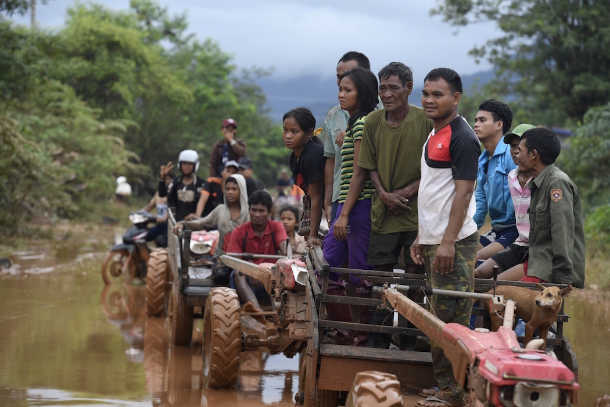
Grim future faced by thousands in temporary camps part of broader problem linked to dam construction in the country

In this file photo taken on July 27, 2018 flood victims wait for food aid in Sanamxai, Attapeu province, southern Laos. Thousands are languishing in displacement camps a year after a dam broke unleashing floodwaters and killing dozens of people in the impoverished country, a new report on the anniversary of the disaster said July 23. (Photo by Nhac Nguyen/AFP)
At around 8 a.m. on July 23 last year an auxiliary dam of the Xe Pian-Xe Namnoy hydropower plant in southern Laos collapsed, unleashing what local villagers later described as an onrushing wall of water.
Dozens, or perhaps hundreds, of local people in several farming villages died in the ensuing deluge that devastated entire communities and displaced some 7,000 people in Champasak Province.
To the villagers the disaster seemingly came out of nowhere that morning. No one had told them the hydroelectric plant under construction upstream could wreak such havoc on their communities and their environs.
Nor had they been told that the day before large cracks were discovered in a part of the dam. Forewarning could have prepared them for an emergency evacuation.
“We had no idea the flood was coming,” a local man identified only as Mr. Vee later told a team of foreign researchers. “I heard people yell outside my house, ‘Flood! Run, brothers and sisters!’” he went on.
“My wife and daughter had not yet returned from the rice fields. I took refuge on a nearby roof, sick with worry,” Vee said.
Later on, he managed to find both his wife and daughter unharmed. “It was a miracle [they survived],” he said.
Others weren’t so lucky.
“I saw dead bodies floating by,” recalled another survivor, Ms. Mai. “It was something I never imagined I would see in my life. There was no warning at all. Suddenly water was pouring in from all directions,” she added.
“[M]y sister and her family are still missing,” Mai said. “My sister is Noy. She’s about 17 years old and has a new baby.”
The burst of the dam at the 410-megawatt hydroelectric plant, which was built on a plateau in the mountainous country, released half a billion cubic meters of muddy water, which had been collected from the nearby Xe Pian River.
The sudden deluge swept away homes as if they were so many cardboard boxes. It also destroyed roads and inundated a large swathe of farmland.
Six nearby villages were entirely destroyed, while in total 19 villages were affected in the calamity. The official death toll has been put at 49 with another 22 people listed as still missing (and presumed dead).
Local villagers and foreign rights advocates, however, insist that several hundred people died in the disaster.
“The official figure is probably a gross underestimation of the actual death toll,” stresses Andrea Giorgetta, head of the Asia Desk at the International Federation for Human Rights (FIDH). “We may never know [the real figure].”
Even some villages across the border in northeast Cambodia were affected by the flood triggered by the collapse of the dam in Laos.
Yet a full year after the deadly calamity no one has been held to account for it. Nor have survivors received anything resembling adequate compensation.
Nearly 5,000 villagers, who have lost their homes and livelihoods, continue to languish in makeshift camps where they subsist on occasional food packages and meager financial allowances provided by the Lao government.
“They remain in temporal camps, facing an uncertain future,” says Maureen Harris, Southeast Asia program director for International Rivers, a U.S.-based environmentalist and rights organization.
International Rivers has just released a damning report on a lack of rehabilitation efforts and accountability in the wake of the Xe Pian-Xe Namnoy hydropower project disaster last year.
“After surviving the loss of their homes, loved ones and farms, [Lao villagers] are being traumatized yet again by being denied adequate food, housing and dignity in the camps,” the nonprofit notes in its report titled “Reckless Endangerment.”
Reduced to penury by the disaster that has claimed all their possessions, thousands of villagers might be forced to stay in these camps for several more years to come.
Worse: floodwater has also inundated their rice paddies, so they have no way of making a living as farmers. “People lost their homes, their farmland, their livelihoods and their way of life,” Harris notes.
Yet despite their losses the villagers have yet to receive any meaningful compensation, activists say.
“It is outrageous that one year after the dam collapsed and unleashed so much destruction and suffering, the victims have still not been compensated,” says David Pred, executive director of Inclusive Development International, a nonprofit that campaigns against the dispossession and exploitation of local people by powerful businesses.
Just as egregiously, Lao and foreign activists say, no one has been held accountable for the burst of the dam, which subsequent investigation has found to have been constructed on unsuitable terrain with questionable standards.
The hydroelectric plant, which was near completion when the dam collapsed and had cost over $1 billion to build, was financed predominantly by four Thai banks and some South Korean government agencies. As much as 90 percent of the electricity the plant was to generate was meant for export to neighboring Thailand.
The project has been a joint build-operate-transfer venture between the Korea Western Power Company, the Ratchaburi Electricity Generating Holding of Thailand (EGAT) and the Lao State Holding Enterprise.
None of these entities have accepted any responsibility for the dam’s collapse, although independent experts say that both the design and construction of the power plant appear to have been substandard and unsuitable for local conditions.
“A growing body of evidence suggests that the dam’s developer and builder, the [South] Korean firm SK Engineering & Construction, may have [accidentally] caused the collapse,” International Rivers says.
Richard Meehan, a Thailand-based expert from Stanford University who specializes in civil and environmental engineering, has found that the reservoir for the dam had been constructed on a sinkhole. Its design was also not suited for the local topography, he argues.
“The disaster occurred in the midst of what some have called a hydropower rush in that small mountainous country,” Meehan explains in a paper containing his findings, “raising questions not only about the care with which these short-lived projects, developed by aggressive teams of international investors and contractors, are being built, but also about the suitability of Laos’ tropical geography for engineering concepts largely imported from western countries.”
Other evidence indicates that the South Korean company cut corners by lowering the height of protective walls for the dam so as to save up on construction costs.
The company has denied such claims, blaming floods triggered by torrential downpours for the dam’s collapse. A company spokesman insisted to South Korean media that “parts of the upper area of the dam were lost due to heavy rains [whereupon] the water [in the dam] overflowed.”
Laos’s government has similarly failed to address the disaster’s causes. “A lack of accountability raises questions about the safety of similar projects across Laos,” Harris observes.
Around the landlocked nation, which is one of the world’s poorest, another 351 hydropower dams are already under construction or in the plans.
The country’s communist government has been seeking to harness the power of the myriad rivers that crisscross the land as a much-needed source of revenue. It is doings so by allowing foreign developers, mostly from China, to build new hydroelectric power plants on local rivers and export the electricity thus derived.
Yet the environmental and social costs of damming many of Laos’ scenic, meandering rivers could be catastrophic, environmentalists warn.
“China is already in complete control of the Mekong through its multibillion-dollar hydropower plant projects,” a Thai environmentalist says. “They make decisions that severely affect many people in several countries in the region without consulting us.”
This July the Mekong’s water in the Golden Triangle — an area where the borders of Myanmar, Laos and Thailand meet — has plunged to record lows. The river’s water has not been this shallow for a century. A prolonged drought has been partly to blame, but new dams on the river upstream have exacerbated the problem by cutting off the flow of water from areas downstream, environmentalists say.
“This could be a new normal for the Mekong River, due to flow regulation by upstream dams and climate change, resulting in prolonged periods of drought,” observes the Stimson Centre, a U.S.-based think tank.
Yet local people in countries like Laos are rarely consulted when momentous decisions are made about their rivers. “Most people in Laos are denied basic rights, including the right to participate in decision-making about construction projects like dams,” Giorgetta, of FIDH, says.
Construction projects like hydropower dams, he adds, affect local people the most, yet often they have the least say in the matter.
And when disaster strikes, as people living in the vicinity of Xe Pian-Xe Namnoy have learned to their cost, locals may end up being left to deal with the consequences and fend for themselves.
Help us keep UCA News independent
The Church in Asia needs objective and independent journalism to speak the truth about the Church and the state.
With a network of professionally qualified journalists and editors across Asia, UCA News is just about meeting that need. But professionalism does not come cheap. We depend on you, our readers, to help maintain our independence and seek that truth.
A small donation of US$2 a month would make a big difference in our quest to achieve our goal.

Share your comments